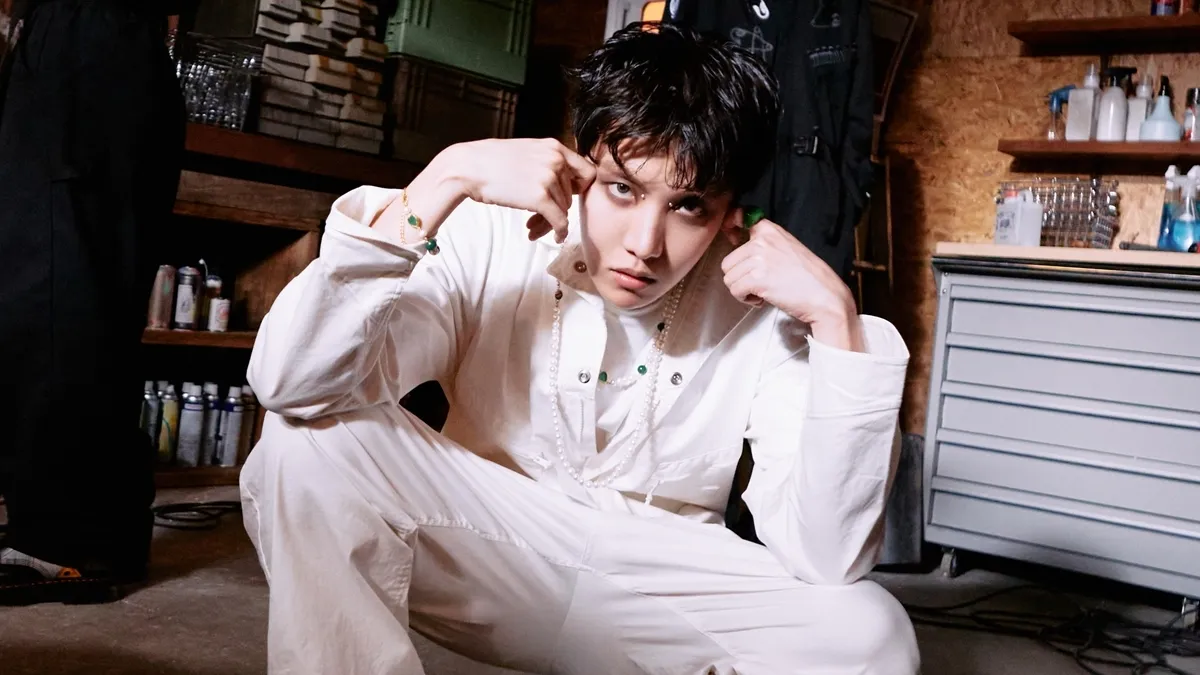MORE
“MORE” may not be everyone’s cup of tea (but as someone who loves rock songs, it is my cup of tea, runneth over), especially to those who want J-Hope’s music to be effervescent and sunshiny, but no one will forget this song after listening to it.
(translated in 2022)
J-Hope boldly kicked off BTS’s new chapter in style with his solo effort, distinctive in sound and edgier in mood. Yet, as I read through the verses and then listened to the song on repeat, loudly and the bass all the way up, while driving, I could instantly recognize the BTS hallmarks in the new work’s theme, lyrics, and beat.
BTS has continuously explored themes about overcoming obstacles, finding life’s meaning when a song makes a connection with fans, and needing to obsessively create to sustain one’s existence. The verses replete with dizzying rhyming schemes, especially the middle rhymes that occur across multiple lines, and clever wordplay are what separates BTS from every other band in Korea. Vibrant, and occasionally experimental, hip-hop songs with raw, vigorous drum beat distinguished BTS from the beginning. But it’s the range of delivery and versatile rhythmic flow is what makes the BTS rap line the best in the business.
In “MORE,” J-Hope incorporates phrases and sounds from their past songs—“Daydream,” “MIC Drop,” “HANGSANG,” “Run BTS,” and “P.O.P,” to name a few. Heck, even the head-banging chorus reminded me of J-Hope’s part (verse 3) in “Ugh:” “They feel angry at anything and everything/ And that has driven them insane, Ugh, Ugh, Ugh, Ugh.” You put in the muffled sound effect and add some Kurt Cobain guitar riff, and boom, we’re in business! Maybe that’s why I felt I’ve known this song forever, even on my first listen.
Without further ado, let’s delve into J-Hope’s sublime lyricism. The intro, first, and second verses are a masterclass in internal (middle) and end rhyming. As I’ve mentioned often, although the world’s foremost linguists consider Korean to be one of the most scientific languages, it is terrible for rhyming due to the grammatical rules and patterns, specifically the conjugations, and shortness of the words. In fact, the notion of rhyming is absent in Korean poetry. That is why Korean rappers focus more on flow and rhythm, unlike American rap, in which rhyming is the most important aspect.
Therefore, the BTS rap line inventively utilizes consonance (the recurrence of similar sounds, especially consonants, in close proximity) and assonance (similar sounds of vowels) to create imaginative rhyming patterns. This is why I’ve been saying that not many Korean rappers can match the rap line when it comes to rhyming skills.
For example, in “Dionysus,” they employ a mixture of dizzying consonance and assonance just in the first three lines of the first verse for internal and end rhyming effects.
consonace:
first line- 소(soh), 스(seu)
second line- 손(sohn), 술(sool), 손(sohn), 소(soh), 스(seu)
third line- 속(sohk), 술(sool)
assonance:
first line: 취(chwih), 치(chih), 디(dih), 니(nih)
second line: 손(sohn), 손(sohn), 소(soh)
third line: 한(hahn), 탈(tahl), 잔(jahn), 찰(chahl), 랑(lahng)
In “MORE,” J-Hope goes full-on Shakespearean with assonance. He starts with end rhyming the first four lines of the intro:
떨스티 (thirsty)
서핑 (surfin’)
물고기 (mool-go-gi)
뮤직 (music)
Then, he rhymes the rest of the lines this way:
모 (mo)
플로 (flow)
고 (go)
In the first verse, he end rhymes the first four lines this way:
중 (joong)
미학뿐 (mih-hahk-bboon)
학습 (hahk-seup) (near assonance)
작품 (jahk-ppoom)
He also creates clever internal rhymes across multiple lines:
밑줄은 (miht-jool-eun)
없는 (up-neun)
나오는 (nah-oh-neun)
J-hope then goes insane for the second verse, end rhyming every line!
댓 (that)
믹스테잎 (mixtape) (near assonance)
백 (back)
스위트해 (sweet hae)
유익해 (yoo-ik-hae)
비트에 (beat-eh( (near assonance)
부주의해 (boo-joo-yi-hae)
들이대 (deul-(y)i-dae)
As if that was not enough, he also internal rhymes every line!
귀에 (gwi-eh), 스내어(snare) (near assonance)
새 (sae), 직행 (jihk-hang)
피드백 (feedback)
달게 (Dahl-geh), 킷캣 (KitKat)
관계 (gwan-gye) (near assonance)
주입해 (joo-ip-hae), 드라이브해 (drive hae)
주의해 (joo-yi-hae)
그림에 (geu-rihm-eh), 취해 (chwi-hae)
Even if you’re not Korean, listen to the second verse very closely and feel how he delivers the middle and end rhymes. Every time I listen to this verse, I get goosebumps.
I love the way J-Hope begins the first four lines of the song with a liquid metaphor:
Yeah, I’m thirsty
Gotta be on top of the beat surfin’
I’m like a fish in the water
Soak up the music
He then comes up with a creative wordplay for the following two lines:
Eenie meenie miney mo
춤 추는 아기 flow (choom choo-neun ah-gih flow) (Dancing baby flow)
J-Hope is cleverly playing with a counting-out rhyme that’s recited in Britain:
“Enie meenie miney mo
Put the baby on the po”
or “Catch a baby by the toe”
In the first verse, J-Hope laments that no matter how much he self-studies, the learning never ends. He talks about underlining important parts with a highlighter, but that only shows the aesthetics of his learning, meaning the underlines look good (mainly to show off to others how much he’s studying), but not much learning is taking place.
However, even if he feels he’s not ready 100%, he makes music since one of his creation could maybe become someone’s favorite song, which gives him happiness and is the impetus that helps him “carry on.” By the way, in this line, “또 누군가의 favorite song,” “또 (ddoh)” could mean 1. again 2. also, too 3. maybe, perhaps. Looking at the context, the correct translation is the third definition—“Maybe it will become someone’s favorite song.”
The 2nd to 4th lines of this verse are simply superb:
내 형광 밑줄은 배움의 미학뿐
끝이 없는 학습
부딪히고 넘어지며 나오는 작품
literal translation:
These underlines with highlighters
Only show the aesthetics of my learning
Learning never stops
Only after setbacks and failures
Comes my creation
context-driven translation:
Underlines with a highlighter look good,
But not much learning is taking place
Learning never stops
My creation comes only after setbacks and failures
A KARMY that I admire even captured these lines and wrote underneath, “Only J-Hope can write such impressive lyrics with amazing rhyming,” on a music website. And I agree wholeheartedly with him.
In the second verse, I like the way J-Hope writes 3rd to 5th lines (“Even if I get (bad) feedback, I get back/ Eat it like it’s KitKat—sweet to me/ reciprocity, so useful”) with sarcasm. He says, “피드백 와도 (Even if I get feedback), I get back,” which means that he did not want the feedback in the first place (perhaps from people high up in the company), but he “gets back” to them anyway. If he wanted to say he really appreciated the feedback he got, he would’ve written, “피드백 오면 (When I get feedback), I get back.”
He then says that he just treats the feedback like a sweet Kit-Kat and then sarcastically utters “appreciate” and “reciprocity is so useful (상호관계, 참 유익해).” The word “참 (chahm) (so, very much, really)” is often used by Koreans when we are being sarcastic. It’s like when Americans say, “You’re really amazing,” when someone does something incredibly stupid or ridiculous.
By the way, the “Kit-Kat” here has nothing to do with the Japanese expression “kitto katsu,” which means “you’ll be victorious,” because J-Hope did not intend this line to be positive. In fact, it is the second verse’s content that makes “MORE” dark and edgy, especially for the people who assume that J-hope is all sunshine and cheerfulness. There is no positive verse or line in this song except the last lines of the first verse.
Finally, I was perplexed about why J-Hope brought up Dali; maybe J-Hope is intimating that he wants to create artistic work which is similar to Dali, whose paintings are not beautiful to look at but leave a lasting impression on anyone who glimpses at them.
“MORE” may not be everyone’s cup of tea (but as someone who loves rock songs, it is my cup of tea runneth over), especially to those who want J-Hope’s music to be effervescent and sunshiny, but no one will forget this song after listening to it.
Lyrics:
Verse 1:
Yeah, I’m thirsty
Gotta be on top of the beat surfin’
I’m like a fish in the water
Soak up the music
Eenie, meenie, miney, moe
Dancing baby flow,
Keep my passion, I gotta go
I’m still…not enough
Self-studying for 11 years,
highlighted underlines only look good
Learning never stops,
My creation comes after setbacks, failures
Not ready, but I make it move
Make it mine, make it right
Maybe it’ll be someone’s favorite song
That’s worth half of my life
and its meaning and joy
An impetus that helps me carry on
Pre-Chorus:
Bring it all
I’m doing it all
Chorus:
Hah, shout out
I say “more”
Hah, yeah, right,
’Cause I want some more
Hah, shout out
I say “more”
Hah, yeah, right,
’Cause I want some more
Verse 2:
In my ear kick snare’s audible, hit that
Moving nonstop without rest, make my mixtape,
Even if I get feedback, I get back
Eat even bad ones like it’s KitKat—sweet
Reciprocity, so useful
Criticism is like gas
I drive again toward the beat
I warn you all, I can be reckless
A Dali painting’s intoxicating, commanding over me
Want it: stadium with my fans, even now
Raking up trophies, along with the Grammy
Fame, riches aren’t everything, I already know it
My work makes me breathe, so I want MORE
Inhale, inhale, exhale, exhale
My craving feels as if it’s alive
Pre-Chorus:
Bring it all
I’m doing it all
Chorus:
Hah, shout out
I say “more”
Hah, yeah, right,
’Cause I want some more
Hah, shout out
I say “more”
Hah, yeah, right,
’Cause I want some more
Outro:
Yeah, I’m thirsty
Gotta be on top of the beat surfin’
I’m like a fish in the water
Soak up the music
Eenie, meenie, miney, moe
Dancing baby flow,
Keep my passion, I gotta go
I’m still…not enough

